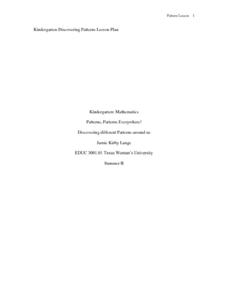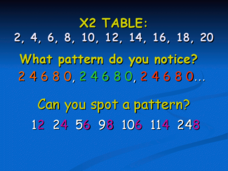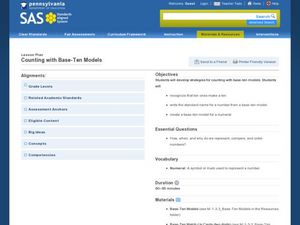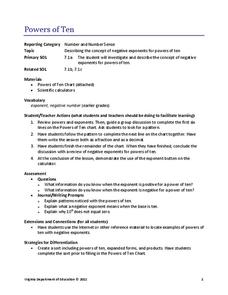All Our Days
Duplo/Lego Tower Pattern Busy Bag
Turn young learners into pattern detectives with this fun hands-on activity. Using the included set of cards showing different block towers, children replicate each pattern with their own manipulatives while...
Curated OER
Patterns With 10
In this patterns worksheet, 1st graders add as many circles as needed to make 10 circles in 9 rows. Students write a number sentence for each row in exercise 10.
Illustrative Mathematics
Making a Ten (Grade 1)
How many ways can first graders make a 10? Using an addition chart, learners color in the 10s on the table. They notice and explain the meaning of the pattern, and how to get to another sum of 10.
Curated OER
Ten by Ten
Learners participate in hands-on activities using a hundreds chart and counting toes and fingers. They discover the patterns that are created when counting by ten. After a lecture/demo, students practice by using a worksheet embedded in...
Texas Woman’s University
Patterns, Patterns Everywhere!
Not only is pattern recognition an essential skill for young children to develop, it's also a lot of fun to teach! Over the course of this lesson, class members participate in shared readings, perform small group...
Curated OER
Ten Red Apples; The Five Senses
A clever lesson designed around an apple awaits your learners. Descriptive words are used to explain what they believe is inside a bag while using their five senses. Students read the story The Apple Pie Tree and are introduced to the...
Curated OER
Multiples of 2, 5, and 10
Build number sense and make learning multiples a simple task with this helpful presentation. The multiples of two, five, and ten are represented first as number patterns. Learners will be able to construct rules based on what they see....
Curated OER
Counting with Base - Ten Models
Help your kids develop strategies for counting. In this base-ten lesson, learners use matching cards, base 10 blocks, and dry erase markers and boards to examine the base 10 counting system.
Curated OER
Patterns
Follow the pattern to find what comes next. Youngsters analyze shape patterns to continue the sequence in the provided space. The three patterns increase in difficulty, and then scholars have a chance to create two of their own....
Curated OER
Identify Patterns
To complete these number patterns mathematicians must determine by what number each is constantly increasing. However, this isn't your typical skip counting; scholars count by numbers like 18, 60, and even 101 to fill in the missing...
Scholastic
Adding and Subtracting Ten
Developing fluency with basic addition and subtraction is fundamental to the success of all young mathematicians. This four-day lesson series begins with learners using ten-frames and hundreds charts to recognize patterns when adding and...
Curated OER
Mental Math: Multiply Multiples of 10, 100, and 1,000 homework 21.1
Pupils use basic facts and patterns to find the products of multiples of tens, hundreds, and thousands. They solve twelve problems.
Curated OER
Patterns of 2s, 5s, and 10s
In order to connect the dots in three images youngsters skip count by twos, fives, and 10s. Encourage them to look for patterns as work, and consider giving out hundreds charts for guidance. They can also color these in once finished!
Curated OER
Identifying Patterns
Find the pattern! Eighteen number sequences challenge scholars to identify and complete the pattern, adding at least four digits to the given numbers. All the sequences here involve skip counting by various single-digit numbers,...
Curated OER
Identifying Patterns
Explore number attributes and skip counting through patterns! Scholars find the pattern in each of these sequences and continue it by writing in the remaining values. They count consistently by various intervals, sometimes forwards and...
Houghton Mifflin Harcourt
Graphs from Patterns
Fifth graders analyze patterns and begin looking at function tables. This is a pertinent preparation for graphing patterns. In fact, consider giving your class a piece of graph paper and then teach them how!
National Security Agency
Growing Patterns: Practical Pattern Problems
Your learners explore growing patterns by describing, extending, creating, and evaluating practical pattern problems in this three-day collaborative unit. Beginning with concrete patterns and function tables to extend and...
Virginia Department of Education
Powers of Ten
Investigate negative exponents of-ten. Pupils use the pattern of increasing powers of 10 to determine negative powers of 10. The scholars write the powers in expanded and product forms and make the connection to exponents using a...
Santa Barbara City College
How to Make a Multiplication Table
Teach children how to make a multiplication table, and they'll be multiplying for life. Following this series of steps, young mathematicians learn to use patterns and the relationships between numbers to create...
Curated OER
Number and Shape Patterns
Review what constitutes a pattern, and have the kids create number and shape patterns of their own. An activity page requires them to name and identify simple numerical patterns.
Curated OER
Naming the Pattern
In this pattern worksheet, 2nd graders complete fifteen number patterns and explain the counting pattern for each group. Students also complete five picture patterns and label each of the patterns.
Curated OER
Make Your Own Quilt
In this quilt patterns worksheet, 2nd graders analyze the pattern in two rows of 12 shapes. Students continue the pattern in the empty grid to complete the quilt design.
Curated OER
Understanding 10: Backwards and Forwards
Help your young mathematicians completely master 10 by practicing one-to-one correspondence, number recognition, and recording numbers displayed. They make 10 with groups of two-different colored cubes and color in 10-frames to show how...
Curated OER
Toothpick Patterns
In this patterning worksheet, students identify and complete 15 different patterns that include using toothpicks. First, they determine the number of toothpicks needed to create each figure in a given sequence. Then, students determine...























